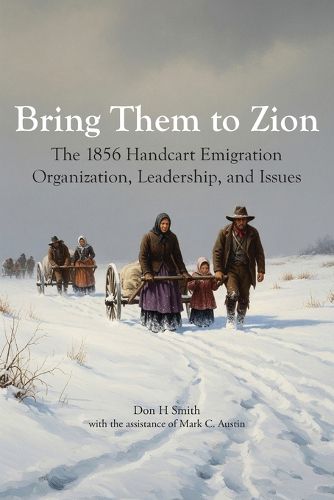Readings Newsletter
Become a Readings Member to make your shopping experience even easier.
Sign in or sign up for free!
You’re not far away from qualifying for FREE standard shipping within Australia
You’ve qualified for FREE standard shipping within Australia
The cart is loading…






This title is printed to order. This book may have been self-published. If so, we cannot guarantee the quality of the content. In the main most books will have gone through the editing process however some may not. We therefore suggest that you be aware of this before ordering this book. If in doubt check either the author or publisher’s details as we are unable to accept any returns unless they are faulty. Please contact us if you have any questions.
Bring Them to Zion: The 1856 Handcart Emigration Organization, Leadership, and Issues offers a deeply researched and meticulously documented account of one of the most ambitious and controversial episodes in Latter-day Saint pioneer history. Drawing on original sources and archival materials, the authors reconstruct the organizational challenges and decision-making processes that led to the infamous 1856 handcart migration. This emigration effort, driven by faith and constrained by logistics, sought to bring impoverished European converts across the American plains with minimal resources-relying on handcarts instead of ox-drawn wagons. The book details how unforeseen weather, financial limitations, logistical miscalculations, and divided leadership all coalesced into tragedy for many participants.
Going beyond recounting events, Bring Them to Zion examines the motivations, planning, and execution behind the handcart experiment; explores the differences and cooperation between Church leaders in Utah, Europe, and the eastern United States; and investigates the internal politics and systemic missteps that affected thousands of emigrants. The narrative sheds new light on Brigham Young's vision, the administrative roles of Franklin D. Richards and other key figures, and the broader context of mid-nineteenth-century transatlantic and frontier migration. This work is essential reading for anyone interested in Mormon history, American religious movements, or the broader story of westward expansion.
$9.00 standard shipping within Australia
FREE standard shipping within Australia for orders over $100.00
Express & International shipping calculated at checkout
Stock availability can be subject to change without notice. We recommend calling the shop or contacting our online team to check availability of low stock items. Please see our Shopping Online page for more details.
This title is printed to order. This book may have been self-published. If so, we cannot guarantee the quality of the content. In the main most books will have gone through the editing process however some may not. We therefore suggest that you be aware of this before ordering this book. If in doubt check either the author or publisher’s details as we are unable to accept any returns unless they are faulty. Please contact us if you have any questions.
Bring Them to Zion: The 1856 Handcart Emigration Organization, Leadership, and Issues offers a deeply researched and meticulously documented account of one of the most ambitious and controversial episodes in Latter-day Saint pioneer history. Drawing on original sources and archival materials, the authors reconstruct the organizational challenges and decision-making processes that led to the infamous 1856 handcart migration. This emigration effort, driven by faith and constrained by logistics, sought to bring impoverished European converts across the American plains with minimal resources-relying on handcarts instead of ox-drawn wagons. The book details how unforeseen weather, financial limitations, logistical miscalculations, and divided leadership all coalesced into tragedy for many participants.
Going beyond recounting events, Bring Them to Zion examines the motivations, planning, and execution behind the handcart experiment; explores the differences and cooperation between Church leaders in Utah, Europe, and the eastern United States; and investigates the internal politics and systemic missteps that affected thousands of emigrants. The narrative sheds new light on Brigham Young's vision, the administrative roles of Franklin D. Richards and other key figures, and the broader context of mid-nineteenth-century transatlantic and frontier migration. This work is essential reading for anyone interested in Mormon history, American religious movements, or the broader story of westward expansion.